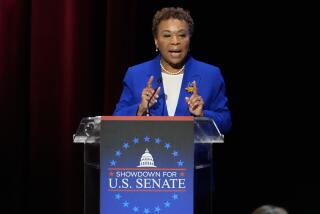How Does a ‘Shocker’ Stay a Winner? : Politics: In Chicago, Carol Moseley Braun uses the Anita Hill-Clarence Thomas dust-up to pick off a near-invincible incumbent in the primary.
- Share via
CHICAGO — Sen. Alan J. Dixon, a two-term incumbent, has been Mr. Democrat in Illinois politics for almost two decades. A top vote-getter for the party in several elections, Dixon, who is from the downstate town of Belleville, was known as “Al the Pal” to both Democrats and Republicans.
In a 1978 contest for secretary of state, he became the only candidate in modern Illinois history to carry every county in the state, every township in suburban Cook County and every ward in Chicago. Undefeated in almost 30 elections, Dixon’s moderate views, campaign war chest and genuine popularity consistently scared off potentially strong Republican opponents.
It was this feeling of near invincibility that led him to vote his conscience and cast an aye vote on Clarence Thomas’ Supreme Court confirmation last autumn. That single action unleashed a firestorm of criticism within his own party and revealed true political vulnerability for the first time in Dixon’s career.
Now Al the Pal is gone, defeated in a shocking upset in Tuesday’s primary by Carol Moseley Braun, an African-American. Braun, as a dramatic pioneer in the heady arena of senatorial politics, will be sought after by many interest groups to advance their agendas. In the face of all that, her success in November depends on whether she can hold the middle ground.
Before her 1988 election as the Cook County (Chicago) recorder of deeds, Braun served in the Legislature as an assistant majority leader and was a floor leader for then-Chicago Mayor Harold Washington and his legislation.
From her college days at the University of Illinois, Chicago, where she studied politics as a student of the legendary Chicago-watcher Milton Rakove, to her primary victory, Braun has been a political realist. Dixon’s unwise Thomas vote gave her an opportunity to leap from a minor county office to big-time statewide politics.
Alfred Hofeld was the third major candidate. A true amateur Democrat with little political experience, Hofeld is a self-made millionaire and personal-injury lawyer. And though he never threatened Braun or Dixon in political strength, he became a pivotal actor in the Braun victory.
Conventional wisdom suggested that Dixon’s two opponents would divide the anti-incumbent vote, thereby giving Dixon a tough but comfortable victory. It did not happen. Why?
First, Hofeld unleashed a barrage of television commercials directed entirely against Dixon. For more than three months, Hofeld pummeled Dixon’s record, character and political longevity in every major and minor media market in the state. Under this pounding (Hofeld spent well above $3 million on ads alone), Dixon’s numbers began to drop slowly.
Second, Braun emerged as a competent and attractive alternative despite having problems raising money to maintain a unified campaign organization. Moreover, Braun recognized the latent frustration and anger of many women in Illinois over the Thomas-Anita Hill controversy and shrewdly played the gender card. This move gave her the opportunity to transcend racial, philosophical or regional loyalties among women voters in both political parties without putting her liberal/black base at risk.
Third, Dixon reacted badly to the political onslaught. Like a fighter who suddenly ages once in the ring, Dixon appeared out of touch with 1992 political realities. His own paid media was terrible, he often disappeared from the campaign trail and during the campaign’s only debate looked like he was standing on eggs.
Finally, vote distribution and old-fashioned luck played an important part. Braun’s winning percentage was under 40%--not exactly a juggernaut. Much of the vote for Hofeld (27%) came at the expense of Dixon, especially downstate. Unbelievably, Dixon’s downstate percentage was under 50%, and it is doubtful that Braun could have garnered many of the 132,00 downstate votes that Hofeld received if she had been in a one-on-one race with Dixon. By expanding her base with women and disgruntled male voters, Braun was able to out-count a wounded Dixon by 40,000 votes.
Now the Illinois U.S. Senate race is a toss-up. Republican conservative Richard Williamson, a former White House aide to Ronald Reagan, will be Braun’s GOP foe in November. An untested campaigner, Williamson will receive huge GOP political and financial support for a suddenly vulnerable Democratic Senate seat.
Braun will also receive much-needed financial support, though will have to avoid becoming a symbolic candidate of national women’s and African-American organizations. She must prevent her campaign from being overwhelmed by outsiders unfamiliar with her fragile plurality coalition. The next U.S. senator from Illinois will be the candidate who is able to move to the political middle without alienating his or her base. In short, it’s wide open.
More to Read
Get the L.A. Times Politics newsletter
Deeply reported insights into legislation, politics and policy from Sacramento, Washington and beyond. In your inbox twice per week.
You may occasionally receive promotional content from the Los Angeles Times.










